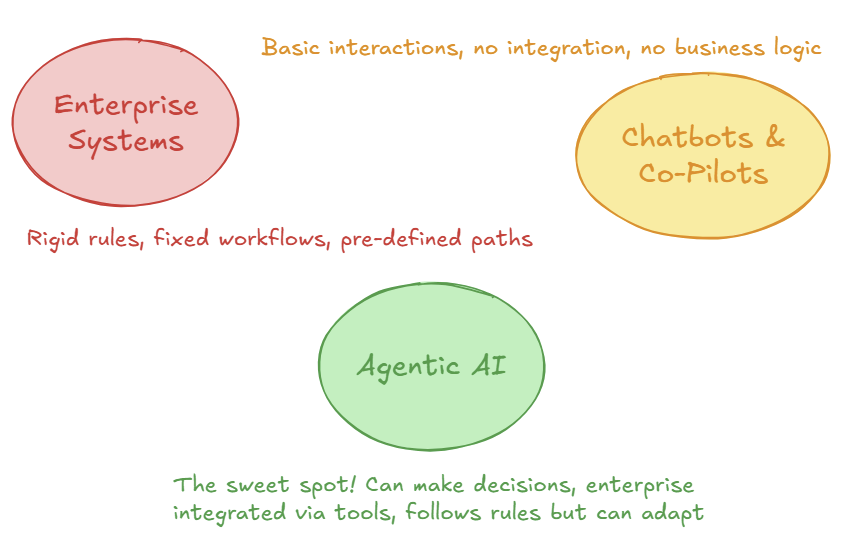Your First Enterprise AI Agent Will Fail (Unless You Follow These 6 Steps)
A Practical Guide to Deploying Agentic AI That Actually Delivers ROI
Quick Take
Deploying your first enterprise AI Agent isn't just about technology — it's about strategic business decisions, organisational readiness, and understanding the transformative impact on your workflows.
This guide will walk you through the essential prerequisites, both technical and organisational, to ensure your first AI agent deployment is a resounding success.
The New Kids on The Block
AI Agents are promising to revolutionise how we work. But like a novice chef attempting a soufflé for the first time, many organisations dive in without proper preparation, only to watch their efforts fall flat.
This isn't just about plugging in a new piece of software; it's about fundamentally re-imagining how work gets done.
Think of it this way: Your enterprise systems are like a train system - powerful but running on fixed tracks. Chatbots are like having a smart assistant who can talk about the journey but can't actually take you anywhere. Agentic AI is like having an experienced driver who knows how to get you where you need to go, follows all the traffic rules, but can also take different routes when needed and coordinate with other vehicles and systems along the way.
However - If you want to take advantage of this technology, here’s what you’ll need to get right before you embark.
#1. Choosing the Right Process: The Foundation of Success
Before you even think about the technical nitty-gritty, you need to identify the right process for your AI Agent to tackle. It's like choosing the perfect plot of land before building your dream house — get this wrong, and everything else becomes an uphill battle.
You want to consider processes that are:
Repetitive and rule-based (contract review or employee on-boarding)
Data-intensive (such as monthly financial consolidation reports)
Time-consuming for human workers (budget compilation or legal document review)
For example, in the context of my Templonix framework, document generation and management is an ideal starting point. It's a process that touches almost every department, from legal to marketing, and often consumes hours of valuable employee time.
Selecting the right process for AI augmentation is like choosing the perfect plot for your dream home — it sets the foundation for everything that follows.
#2. Assessing Your IT Landscape: Preparing the Ground
Once you've identified your target process, it's time to take a hard look at your existing IT infrastructure. This is akin to surveying the land before breaking ground on that house — you need to know what you're working with.
Key areas to assess include:
Data accessibility and quality
Integration capabilities with existing systems
Security and compliance requirements
Scalability of current infrastructure
Your IT landscape is the soil in which your AI agent will grow. Make sure it's fertile ground, not rocky terrain.
Data accessibility and quality concerns might include whether your customer data is trapped in legacy systems requiring manual extraction, or if your operational data is standardised enough across departments to be reliably processed.
Integration capabilities with existing systems could involve whether your ERP system has modern APIs available for real-time data exchange, or if your CRM system can handle automated updates from other business applications.
Security and compliance requirements might include whether your data handling meets GDPR standards for automated processing, or if your system logging capabilities can provide the audit trails required by industry regulators.
Scalability of current infrastructure considerations include whether your network bandwidth can handle increased automated processing loads during peak business hours, or if your database systems can manage the higher transaction volumes that come with automated workflows.
#3. Governance, Ethics and Guardrails: Building the Regulatory Framework
Just as you wouldn't build a house without understanding local zoning laws, you shouldn't deploy an AI agent without a solid governance structure in place. This is where many organisations stumble, treating AI as just another IT project rather than a fundamental shift in how decisions are made.
Consider:
Establishing an AI ethics committee
Developing clear guidelines for AI decision-making
Creating audit trails for AI actions
Ensuring transparency in AI-driven processes
With Templonix, for instance, we've built in features for detailed logging and audit trails, making it easier to maintain governance over AI-generated documents and communications.
Governance isn't just red tape — it's the blueprint that ensures your AI agent is a trusted member of your team, not a loose cannon.
#4. Employee Readiness: Preparing Your Team
Deploying an AI agent is like bringing in a new, highly skilled team member. Your existing staff need to be prepared for this new colleague, understanding how to work alongside it effectively.
Key steps include:
Training programs on AI collaboration
Clear communication about AI capabilities and limitations
Redesigning workflows to incorporate AI assistance
Addressing concerns about job displacement
Your AI agent is joining the team, not replacing it. Prepare your staff as you would for any high-impact new hire.
In our experience with Templonix, organizations that invest in comprehensive employee readiness programs see adoption rates soar, with AI agents quickly becoming indispensable team members.
#5. Technical Implementation: Bringing Your AI Agent to Life
Now we're at the stage of actually "building the house" — implementing your AI agent. This is where the rubber meets the road, and where your earlier preparations pay off.
Key technical considerations include:
Decide on the language model you’ll use - Buy Vs Build
Choosing the tech stack that’s right for your organisation
Knowing the data preparation and cleaning that needs to be done
Make sure API integrations with existing systems can be accessed by the Agent via tools
Plan for change in your testing and quality assurance processes
Technical implementation is where vision becomes reality. It's complex, but with the right foundation, it's where the magic happens.
#6. Measuring Success: Evaluating Your New AI Team Member
Just as you'd evaluate a new employee after their probationary period, you need clear metrics to assess your AI agent's performance. This isn't just about ROI — it's about understanding how the AI is transforming your operations.
Key metrics might include:
Time saved on automated tasks
Employee satisfaction and productivity
Sales!
Measuring AI success isn't just about numbers—it's about understanding how your business is being transformed.
Key Takeaways
Let's distill the crucial insights for successfully deploying your first enterprise AI agent:
✅ Choose Wisely, Deploy Strategically
Selecting the right process for AI augmentation is critical. Focus on high-volume, rule-based tasks where an AI Agent can make a significant impact.
🔧 Prepare Your IT Landscape
Ensure your existing systems are ready for AI integration. Data accessibility, security, and scalability are key.
🏛️ Establish Robust Governance
Create clear guidelines and ethical frameworks for AI operation. Transparency and accountability are non-negotiable.
👥 Invest in Your People
Prepare your team for collaboration with AI. Training and clear communication are essential for successful adoption.
📊 Measure and Iterate
Set clear metrics for success and be prepared to adapt based on real-world performance.
If you're embarking on your AI agent journey or planning to do so soon, I'd love to hear about your experiences and any challenges you're facing.
Drop a comment below or reach out directly - I read every response.
Until next time,
Chris




